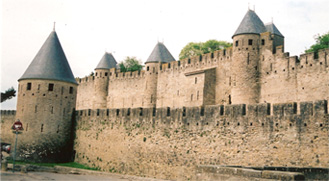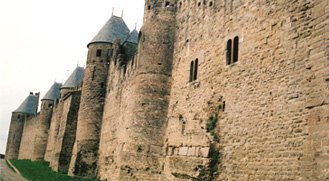

Carcassonne

The Saunière Society was founded in 1985 . It is dedicated to the pursuit of Truth in all things and to the truth behind the mystery of Rennes-le-Château
in particular. We support the research and work carried out by the authors of "The Holy Blood and the Holy Grail" (by Richard Leigh with two co-authors Michael Baigent and Henry Lincoln) without whom the mystery would never have become widely known.
Starting from a pin-point on the map of France, research has led to a most intricate labyrinth of diverse information which has caused many books to be written and further researches to be carried out. Even by the time of the publication of the first book in English the web had spread geographically from the Languedoc to Italy, Spain, Switzerland, Egypt, Scotland, the USA, Canada, South America, Iceland and seemingly all points in between. Historically it covers a time-span thought to stretch over some thousands of years with strong hints that it might stretch even further. Scientifically it revealed a number of enigma that screamed for in-depth research.
To artists of all disciplines the involvement of illustrious names over many centuries, using hard-to-discover techniques, developed perhaps to safeguard
an underground stream from the ravages of an intolerant , vicious, autocratic and very powerful system. Like the legendary Grail the mystery not of,
but in and around Rennes-le-Château, seemed to supply all who came to it for nourishment with whatever is ones favourite (intellectual) food.
The historian finds history such as few even dreamed existed; the mathematicians finds mathematics to send them off in new directions;
the geometer geometry; the poet finds poetry; the artist music, painting, dance or whatever they most want. A thousand flavours from a single pot.
To some researchers the Rennes-le-château affair appears to have the same limits as our universes.

Holy Blood, Holy Grail
The original work of Baigent, Leigh and Lincoln left out some of what was to be "discovered" or re-enforced by later in-depth research.
The Cathar "heresy," Bernard of Clairveaux and the Knights of the Temple of Jerusalem; Alchemy; various occult groups; Geometry both sacred and secular;
Nicholas Poussin's unsuspected revival and use of an ancient technique of building into great works of art that flowed naturally and apparently spontaneously, an
underlying rigid mathematical and geometrical structure that could be used as a vehicle to expand, expound or even expunge the obvious message of the
main work.
Even the earliest television programmes by the BBC showed geometry that derived from an allegedly old parchment and astonishingly, were
duplicated on the ground and marked out by a mixture of natural and
constructed features. Those same parchments revealed techniques of
encryption and apparent secret messages which true or false, showed that there were secret paths which heretics, dissidents,
victims and numerous others could and did take in order to survive, long after the last of them was thought to have gone from the world stage.
At the very least they showed that it was conceivable that what was believed to have been destroyed might still be extant.
Then came the publication of a great variety of books on the mystery of Rennes-le-Chateau since there had been little available in France and such as there was, were not always very illuminating. These included books such as Le Tesor du Triangle d.Or by Jean Luc Chaumeil, Franck Marie's Etude critique and La Ressurrection du "Grand Cocu" Le Tresor veritable de Rennes-le-Chateau (Aude), La "sortie de l'ermite "et la "Catharisme" and Le Surprenant message de Jules Verne; Le Grand Secret des "Rose-Croix' by Roger Facon; Ouverture sur L. 'Invisible by H. Elie; Le Dessous d'une ambition politique by Mathieu Paoli amongst numerous others.
Then there was the re-introduction to the general public of one of the most enigmatic characters to haunt the whole affair- the abbe Boudet
from the neighbouring parish of Rennes-les-Bains- and his strange book first published around 1886 which still causes researchers great concern –
La Vraie Langue Celtique et Le
Cromleck de Rennes-les-Bains. Also reprinted and re-introduced were books by that equally enigmatic
character Otto Rahn, author of Kreuzzug gegen den Gral (Croisade contre le Graal). Dennis Boudaill pub
lished Cle du Meridien Magigue to go with le dossier secret de Rennes-le-Château, Initiation et connaissance of Jean-Pierre Monteils.
Then there were books similar to Abrege de l'histoire des francs Les Gouvernantse et Rois de france by Louis Vazart and Le Comte de Razes et le
Diocese d'Alet by Louis Fedie; to say nothing of Gerard de Sede's works. The trickle turned into a flood and by 1985 enough books had been published to
justify the publication of a small book with a fairly exhaustive bibliography to that date.
By 1986 the three co-authors had published The Messianic Legacy followed in 1989 by Michael Baigent and
Richard Leigh's The Temple and the Lodge which introduced the problem of the Templars in Scotland, the
origins of Free Masonry and the alleged mystery of Rosslyn Chapel. David Wood had already published his GENISIS (1985) which was the
first in-depth study of the geometry at Rennes, the Ancient Egyptian
connection and a number of other (still unexplored) esoteric ideas.
The publication of The Tomb of God by Paul Schellenberger and Richard Andrews in 1996 provided renewed interest in the subject (followed by a televison programme that almost destroyed it) and if nothing else, endorsed the existence of a valid problem concealed within the geometrical patterns in parchments (old or modern, true or false) that have not to this day been satisfactorily deciphered. Earlier in 1991 Henry Lincoln had published his own geometry of Rennes-le-Chateau in his "The Holy Place" which he followed in 1997 with his "Key to the Sacred Pattern", which remains one of his most readable and lucid accounts of "...where we are at..."
Some may wonder why so many obviously highly intelligent men, should spend so long in trying to unravel a mystery located in a tiny and remote mountain village of the Languedoc? It has long been a common saying that the nearer to the heart of the Vatican the more atheists one finds. In complete contrast one might say that the nearer to the heart of the mystery of Rennes-le-Chateau one gets the more sincere, intelligent, honest and single-minded the researchers.
The most amazing thing of all is that as great brains study the Ancient Civilizations of Sumer, Egypt, Bablon, India, etc., and their extant records, ranging from the great work The Mahabharata, to the oldest known book – The Epic of Gilgamesh – through the Pyramid Texts, to the "heretical" and occulted documents of the Gnostics, Cathars, Merovingiens, Gypsies, Troubadours, Minnesangers, Knights of the Temple, Alchemist, The Stories of the Grail, and the whole host of related (and unrelated if you will) documents; throughout it all and over many thousands of years, the most important ingredients of the story have somehow miraculously survived, but can never be written.